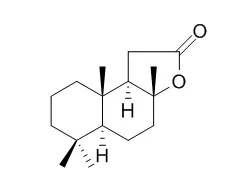Pancreatic cancer is a type of cancer, which rapidly develops resistance to chemotherapy. Gemcitabine is the treatment used clinically, however, gemcitabine resistance leads to limited efficacy and patient survival rates of only a few months following diagnosis.
METHODS AND RESULTS:
The aim of the present study was to investigate the mechanisms underlying gemcitabine resistance in pancreatic cancer and to select targeted agents combined with gemcitabine to promote the treatment of pancreatic cancer. Panc‑1 and ASPC‑1 human pancreatic cancer cells (HPCCs) were used to establish the experimental model, and HPCCs were exposed to gemcitabine of serially increased concentrations to generate gemcitabine‑resistant cells (GR‑HPCCs). The anticancer effect of gemcitabine combined with Sclareolide was then assessed. Epithelial to mesenchymal transition (EMT), human equilibrative nucleoside transporter 1 (hENT1) and ribonucleoside diphosphate reductase 1 (RRM1) were detected in the HPCCs and GR‑HPCCs, and the mechanisms were investigated. Sclareolide resensitized the GR‑HPCCs to gemcitabine. The expression levels of hENT1 and RRM1 were lower and higher, respectively, in GR‑HPCCs, compared with HPCCs. Sclareolide upregulated hENT1, downregulated RRM1 and inhibited gemcitabine‑induced EMT through the TWIST1/Slug pathway in the GR‑HPCCs. In addition, Sclareolide mediated the NOTCH 1 intracellular cytoplasmic domain (NICD)/glioma‑associated oncogene 1 (Gli1) pathway, which triggered TWIST1/Slug‑hENT1/RRM1 signaling and resensitized GR‑HPCCs to gemcitabine. Finally, Sclareolide resensitized GR‑HPCCs to gemcitabine through inducing apoptosis; in vivo, the co‑administraion of Sclareolide and gemcitabine effectively suppressed tumor growth.
CONCLUSIONS:
Sclareolide may be a novel agent in combination with gemcitabine for the treatment of gemcitabine‑resistant pancreatic cancer, which resensitizes GR‑HPCCs to gemcitabine through mediating NICD and Gli1. |






 Cell. 2018 Jan 11;172(1-2):249-261.e12. doi: 10.1016/j.cell.2017.12.019.IF=36.216(2019)
Cell. 2018 Jan 11;172(1-2):249-261.e12. doi: 10.1016/j.cell.2017.12.019.IF=36.216(2019) Cell Metab. 2020 Mar 3;31(3):534-548.e5. doi: 10.1016/j.cmet.2020.01.002.IF=22.415(2019)
Cell Metab. 2020 Mar 3;31(3):534-548.e5. doi: 10.1016/j.cmet.2020.01.002.IF=22.415(2019) Mol Cell. 2017 Nov 16;68(4):673-685.e6. doi: 10.1016/j.molcel.2017.10.022.IF=14.548(2019)
Mol Cell. 2017 Nov 16;68(4):673-685.e6. doi: 10.1016/j.molcel.2017.10.022.IF=14.548(2019)